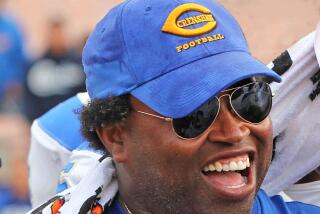Academy Believed to Be First of Its Kind : Crenshaw High Turning Out Future Teachers
- Share via
At 17, Gail Flowers has already experienced some of the rewards of what she plans to make her lifelong profession--teaching in elementary school.
“It may sound corny,” she said, “but it’s the feeling that you get when you say something to a child and then, suddenly, a light goes on in his head, and you know that you caused that, you caused that light . . . and what you taught him will never leave him.”
Flowers is one of 54 students graduating in June from Crenshaw High School’s Teacher Training Academy, believed to be the first high school program in the nation to specialize in training students for teaching careers.
Academic Muscle
The goal of the teaching academy, one of 86 specialized magnet schools in the Los Angeles Unified School District, is to attract young talent, particularly minorities, to the field of education. Another aim has been to add some academic muscle to the predominantly black Crenshaw High School, which has long had a national reputation as a basketball powerhouse, but not an academic one.
In the three years since it was formed, the teaching academy has been described by educators as a model program in California, where it has been estimated that at least 85,000 new teachers will be needed by the mid-1990s.
This year more than 90% of the seniors in the program will go on to college. More than half of the graduates will leave with averages of 3.0 or better. And most have dreams of becoming teachers.
Despite this record of achievement, administrators of the small academy say they are fighting an uphill battle against two deep-seated prejudices: the reluctance among students to choose teaching as a profession and the reluctance of whites and some blacks to go to inner-city schools.
“It doesn’t say much for what people think about the profession, or for what people think of the community,” said Marcella Saunders, who coordinates the program. “I think in both cases they are wrong.”
Saunders said that this year a major push was made to boost the number of students applying to the program. She spoke to more than 1,500 students and sent letters to about 100 junior high school administrators describing the program. The academy was spotlighted in public service messages on television and in the district bulletin Choices, which describes magnet programs. Still, Saunders said, among the thousands of students applying to attend a magnet school next fall, only 48--one white--included the teacher academy as one of the three choices each applicant is allowed.
Emphasizing the positive, Saunders said she points out to prospective academy applicants that beginning teachers earn an annual salary of about $23,000 in the Los Angeles Unified School District and work about 180 days a year.
The students, however, are influenced by societal attitudes, Saunders said. “Teachers are considered baby-sitters, and they have less respect than doctors and lawyers,” she said. “However, next to parents, a teacher is the most important person in a child’s life. In many ways, they are responsible for the doctors and lawyers.
“But in this era of the ‘me generation,’ it is hard to sell teaching to students who have been socialized against it,” she added. “I appear before classes and ask, ‘Who wants to be a teacher,’ and no one raises his hand, you hear nothing, or you see the teacher whose class you are in standing behind you (grimacing).”
The academy has also been hampered by the inability to attract the integrated mix of students for which the magnet programs are designed. Of the 137 students enrolled in the program, 128 are black and the remaining nine are Latino. Crenshaw has a total enrollment of about 1,700 students.
Among inner-city magnets, however, Crenshaw’s Teaching Academy is not unique. Even though the magnets were set up to promote voluntary integration, most in the inner city have remained overwhelmingly minority.
Saunders said the counselor at one Westside junior high school where she wanted to recruit students, asked her, “What is the point? You know the white students are not going to go there, and the black students (who are bused to outside schools for integration) have already left and they are not going back.” Saunders said the counselor promised to let her know when she could come by and talk to the students, but the counselor never called back.
Crenshaw’s principal, Jewell R. Boutte, said that up to 50% of the students living within the high school’s boundaries are either bused out for integration or attend private schools.
Boutte has focused much of her attention on convincing area parents that the education offered at Crenshaw is “just as good” as other schools in the district. She said the dramatic improvements that Crenshaw students have made in reading, writing and math scores on the California Assessment Program over the last three years have earned the school $95,000 in state funds given for improved scores.
She said that one of the first priorities has been to dispel the myth that the school is unsafe. When it comes to student behavior, “we have high standards . . . for ourselves, and therefore we expect it of others,” she said. She noted the lack of graffiti on campus as an example.
Students in the academy study child development, teaching methods, classroom management and education philosophy. They receive special lectures from professors from the School of Education at Cal State Los Angeles.
In addition to mastering their academic requirements for college, academy students practice making lesson plans, preparing bulletin boards and teaching classes in a local elementary school.
More to Read
Sign up for Essential California
The most important California stories and recommendations in your inbox every morning.
You may occasionally receive promotional content from the Los Angeles Times.










